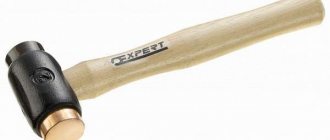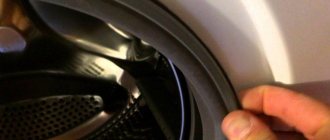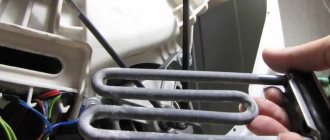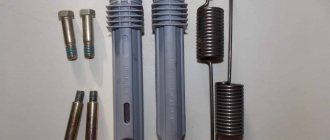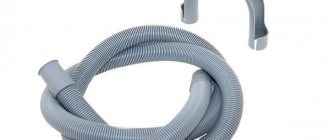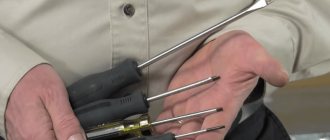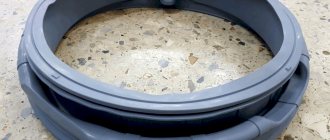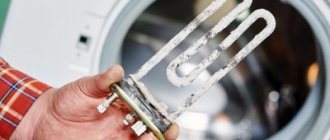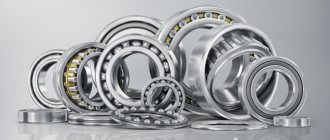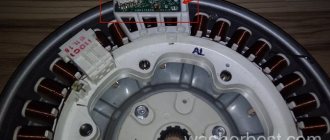A tubular electric heater (TEH) is one of the main elements when operating a washing machine. With the help of this device, water is heated during washing, as well as temperature control is maintained. The element is heated due to a heat-conducting electrical insulator, in which a conductive thread with a certain resistance passes.
If the heating element stops heating the water, you need to immediately deal with this problem, since such a malfunction can lead to failure of the washing unit or its individual parts.
Operating principle of the heating element
The water that the heating element heats can be of any kind, for example, if the water has impurities or is hard, then during its heating scale will form, which can break your washing unit at any unexpected moment, provided that you do not clean it regularly .
This is not the only reason why a washing machine may fail. If you notice that the water in your structure does not heat up, then most likely your heating element is broken. You need to urgently check the heating element, and if it is broken, buy another one.
If you want to do this without the help of specialists, then for this you need to know how to change/repair the heating element yourself. Now we will tell you how to check the operation of the heating element yourself, where is its location and how to understand whether it is broken or not.
Preventive measures
To avoid damage to the heating element, first of all you should carefully read the instructions and use the device as described in it. It is also important to properly care for the unit. For example, detergents should be used only those intended for automatic washing machines.
When choosing, you should pay attention to ensure that the powder and other substances are of high quality, since counterfeiting can lead to significant damage to the device.
Scale forms when water is too hard. This problem is inevitable, so you should periodically use special chemicals to solve it. It is also necessary to clean the internal parts of the washing device from scale and dirt.
Location of the heating element
To repair the heating element or replace it, you must first find out where it is located. There are many different types of washing machines in the world, but mostly the heating element is located at the bottom of the tank.
But you won’t be able to get to it easily, although for the most part it depends on the model of your unit. In some designs, the heating element is located behind the front cover, in others - behind the rear panel. There are cases when the heating element is located on the side, but this is mainly in washing units with side loading.
First, you need to determine where your heating element is located, to do this, remove the back panel and look under the tank to see if this device is there, if it is there (it’s easy to determine, because the heating element, as usual, will be the first from the back cover and is quite easy to remove), then you need to remove it.
If there is no heating element behind the back panel of the machine, then all that remains is to look behind the front cover. So, we have already overcome the first step. Now you need to pull out the heating element and check whether it is broken or not, and if so, replace it.
In the future, we will tell you how to do all this one by one, and also provide two ways to disassemble the washing structure. The first method will be deployed if your heating element is located behind the front panel, and the second method when the device is located behind the back cover.
Here are a few rules that are recommended to be followed when disassembling the structure (does not depend on the model and type of washing unit):
- When disassembling the washing machine, you need to make sure that the machine is unplugged from the network; if not, then do it immediately by unplugging the plug from the socket.
- Before disassembling, it is necessary to drain all the water from the tank; to do this, use a drain filter or otherwise use a drain hose. To drain the water from the hose, you need to lower it slightly below the level of the machine.
- In any case, some amount of water will still remain in the tank, therefore, it is necessary to keep some container and floor rags nearby.
The preparatory work has been completed.
For future work you will need the following tools:
- A set of screwdrivers (flathead, Phillips, and possibly Torx);
- A wrench, either a socket or an open-end wrench, size 8 or 10.
As you can see, no special tools are required when removing the washing structure, and it is already becoming clear that the heating element can be repaired and replaced without any help from specialists.
Peculiarities
The heating element for the Samsung washing machine is made in the form of a curved tube and is installed inside the tank. The tube is a body in which there is a spiral that conducts current. The base of the housing contains a thermistor that measures temperature. The wiring is connected to special terminals on the heating element.
In fact, a heating element is an electric heater that allows you to turn cold water from the tap into hot water for washing. The tube can be made in the shape of the letter W or V. The conductor located inside has a high resistance, which allows water to be heated to elevated temperatures.
The heating element is covered with a special dielectric insulator, which correctly conducts heat to the steel outer casing. The ends of the working spiral are soldered to the contacts to which voltage is applied. The thermal unit, located next to the spiral, measures the temperature of the water in the tank of the washing unit. Activation of the modes occurs thanks to the control unit, while a command is sent to the heating element.
The element is intensely heated, and the resulting heat warms the water in the drum of the washing machine to the set temperature. When the required indicators are achieved, they are recorded by the sensor and transmitted to the control unit. After which the device turns off automatically and the water stops heating. Heating elements can be straight or curved. The latter differ in that there is a 30-degree bend next to the outer bracket.
Samsung heating elements, in addition to the protective anodized layer, are additionally coated with ceramics. This increases their service life even when using hard water.
It should be clarified that heating elements differ in operating power. In some models it can be 2.2 kW. This indicator directly affects the rate of heating of water in the tank of the washing device to the set temperature.
As for the normal resistance of the part, it is 20-40 Ohms. Short voltage drops in the network have almost no effect on the heater. This is due to high resistance and the presence of inertia.
How to get there
Before removing the heater, it is necessary to disconnect the wiring from its terminals. At the same time, it is important not to forget exactly how the wires were installed, so as not to confuse them during further assembly of the machine. Otherwise, the unit may fail and more expensive repairs will be required.
Of course, in addition to disconnecting the wires and de-energizing the machine, you should completely drain the water from it, and do not forget to remove any remaining moisture from the drain filter. The heating element in washing machines is secured with one nut located in the center of its fastening. It needs to be loosened (without unscrewing completely). Then, by hand or using a hammer or screwdriver, you need to push the pin on which the nut sits inside.
If the washing machine has vertical loading of laundry, then to remove the heating element you will have to remove the right panel (when looking at the machine from the front) by unscrewing the fastening screws on the side. After this, you can remove the plastic panel that covers the drain filter. It is located at the front of the car, at the bottom. Both screws are completely unscrewed. They also attach the side wall.
When all the screws are removed, the panel is moved by hand a little towards the back wall, and then down. Now you can take it out and put it away so it doesn’t interfere with your work.
Heating element, which is located behind the front panel
As mentioned above, mostly in washing machines the heating element is located behind the rear panel. Perhaps your washing unit is from Bosh, Samsung or LG, then behind the back cover you can only find a drive belt attached to the motor.
In the design of such companies, the heating element is located on the front side (front panel) directly under the drum.
We suggest doing further work step by step:
- The first step is to remove the top cover of the washing unit. The cover is held in place by two screws that must be unscrewed. Their location is always at the back. The screws must be unscrewed with a flat or Phillips screwdriver; you may need a Torx screwdriver (in a few cases). After unscrewing the screws, carefully lift and pull the cover back and you can easily remove it.
- Second step. It is necessary to remove the box for detergents (powders, etc.). This tray will also be screwed to the machine with two self-tapping screws, which need to be unscrewed. On the parallel side of the front panel there is a latch, by pulling which you can remove the box.
- The third step will be to remove the steel hoop. This hoop holds the rubber seal on the loading hatch. This ring tightens a simple wire spring. In order to remove the above elements, it is necessary to stretch this spring a little and pull out the parts accordingly.
- Fourth step. Removing the rubber seal.
- The fifth step is to unscrew the screws located on the front or bottom of the front cover. When you find them and unscrew them, we proceed to removing the cover. Be careful and attentive when preparing to replace the heating element in the washing machine, because the cover can be attached not only with bolts and self-tapping screws, but also with clips. Therefore, it is better to remove the cover in the following way - simply move it forward a little and then lower it down.
- Sixth step. Not far from the hatch there is a door lock. There is no need to unscrew or remove it, you just need to disconnect the wires. Now it is possible to remove the cover and begin removing the heating element.
- Seventh step. The heating element is located at the bottom of the tank. At the end of this device you will notice a ground wire, power terminals (two pieces), and a connector for a temperature sensor.
- The eighth step is to remove the terminals, disconnect the ground and remove the temperature sensor. If you want to connect everything correctly and successfully in the future, then it would be best for you to remember the locations of the disconnected wires, write them down or take a photograph.
- Ninth step. All that remains is the nut, which must be unscrewed with a wrench (open-end or socket). There is no need to unscrew the nut all the way. Press the bolt inward a little, after which you can remove the heating element.
- Tenth step. To remove it, simply wiggle it up and down and then carefully remove it.
- Eleventh step. Tank maintenance is necessary. To do this, simply clean the tank of scale, detergents and other debris. Now let's move on to the main thing, replacing the heating element.
- Twelfth step. Purchase a new heating element in advance (we recommend starting from the model that you originally had). Insert the new device after connecting the temperature sensor to it. If there are guides, then you need to get into them and also push the heating element inside. After that, screw the nut back, while attaching the remaining wires to the heating element, use a photograph that will show how everything was in place of the previous heating element (the photograph is discussed in the eighth step).
- The last, thirteenth step will be the reassembly of the washing unit.
Signs and causes of malfunction
The likelihood of malfunctions depends on the correct operation of the equipment and the implementation of preventive measures.
The reasons for heater failure may be the following:
- Factory defect. This happens even with trusted manufacturers. The spiral burns out, holes are formed in the housing.
- Scale. During the washing process, insoluble salts settle on the heating element. When there are a lot of them, the element heats up longer, which leads to its combustion.
- Wear. Each product has its own resource. Constant temperature changes and metal fatigue lead to the destruction of the wire inside the sheath.
- Voltage fluctuations. Heating elements are designed to operate in a narrow range of current values. Exceeding its voltage and force disables the product.
Breakdowns on the Indesit washing machine are not uncommon. Based on this, it is not difficult to find the necessary replacement part on sale.
Reasons why heating elements fail
The first reason is a manufacturing defect. Such a breakdown is rare, but it does occur. When purchasing even a new washing machine, there is a risk of purchasing defective components.
The second problem is scale, which settles on the electric heater and impairs the operation of the heating element. Once the metal body of the heater is covered with scale, the thermal conductivity decreases. Heat cannot be completely transferred to water, and the heating element overheats. Having received more heat than needed, the heating element fails. Scale actively forms when the temperature reaches more than 60 degrees; washing at a lower temperature is considered optimal.
Scale also promotes the formation of corrosion, which alters the metal shell. Having lost its tightness, the heating element becomes unprotected from external influences, and there is a risk of fires and short circuits. To avoid this type of breakdown, it is recommended to clean the inside of the machine with special means every few months.
One of the reasons that worsens the performance of the heating element is the use of unsuccessful detergents. The use of hand washing powder or its excess for one wash has an effect on the heating element and envelops it with a film. Therefore, it is better to use special anti-scale products.
Another reason for overheating, which is associated with the contact of various solid objects, skeins of wire, thread, and small pieces of fabric from laundry on the heating element.
Before washing, be sure to check the pockets of clothes placed in the machine and remove all unnecessary items.
Other reasons for failure of the heating element of a washing machine are voltage surges, especially for houses in the private sector. In bad weather and a thunderstorm, it is better to turn off the power to the washing machine. If overheated for this reason, the heating element will look like new in appearance. There will be no visible signs of overheating or scale, but the heating element will not work.
There are times when the heating element turns on to heat water that has not entered the tank of the machine, and the heating element burns out. If a fuse is provided in the heating element pipe, then the damaged part appears without external damage. If there is no fuse, then an indicator of overheating of the heating element due to the lack of water will be the dark color of the metal tube, in some places peeling scale from elevated temperature conditions.
The new heating element can be installed in washing equipment after preventing the lack of water in the tank.
Heating elements may have the following types of faults:
- Heating element rupture. With such a problem, the thread burns out, the electrical circuit breaks, and the heating element stops working. Such a malfunction entails a complete replacement of the part.
- Current leakage, short circuit. Here the insulating layer of the heating element changes and a current appears on the body of the machine. With this malfunction, the part also changes.
- As a result of the formation of a layer of scale, the heating element burns out completely, swells and is a consequence of electric current leakage. The surface of the heating element can be cleaned with special means or using citric acid.
Failure of the heating element occurs for a number of reasons, but you can try to avoid it in advance:
- The cause of hard water can be eliminated by installing filters that make it soft and thereby prolong the operation of heating elements. Preventative work to clean the heating element will also not be superfluous.
- Low mains voltage leads to an increase in current strength, and the core of the heating element may burn out. In this case, a voltage stabilizer is installed and the cause of its damage is eliminated.
- The temperature controller fails and does not send a timely signal about its change. As a result, the heating element overheats. If the regulator breaks down, it is unlikely that the heating element will turn off at the right time. If a problem is detected in time, it can be avoided in a timely manner.
Preparation for repair
Before starting repair work, the washing machine must be disconnected from the water supply and electrical systems. To ensure easy access, the machine is moved to an open and spacious area.
To perform the work you will need to prepare the necessary tools:
- screwdriver - flat and Phillips;
- wrench;
- a device for measuring current resistance - a multimeter.
Work on replacing the heating element must be performed in a well-lit place; sometimes, for convenience, technicians use a special headlamp.
In Hotpoint Ariston washing machines, the heating element is located on the back of the body. To open access to the heating element, you will need to remove the back wall of the machine body. The heating element itself will be located below, under the water container. For some models, you do not have to remove the entire back wall; to replace the heating element, you will only need to remove a small plug to open an inspection window, where in the right corner you can see the element you are looking for.
Experienced technicians recommend using a phone camera to record the initial state of the heating element and the order in which the electrical wires are connected to it. This will greatly simplify the reassembly procedure for you later and will help you avoid annoying contact connection errors.
When all the preparatory work has been completed, you can begin to dismantle and replace the heating element.
How to remove heating element on an Indesit washing machine
Before removing the heating element from the Indesit washing machine, you need to make sure that it is the cause of the breakdown. For this:
- We disconnect the washing machine from the outlet and water supply, and, if necessary, from the sewer.
- We place it in a free place for repairs;
- We turn it towards us with its back side;
- Remove the rear inspection cover of the case by unscrewing the screws that secure it;
- We remove the wires from the heating element, which is located in the lower part of the tank (we rewrite the location of the wires or take photographs for correct reassembly) and test it with a multimeter or a test light for integrity and breakdown on the body.
Disassembly for replacement on top-loading models
In these machines, to get to the place where the part is replaced, you need to:
- Remove the right removable part of the housing;
- Turn the product towards you with this side;
- Unscrew the screws from the end on the right;
- Remove the plastic false panel from the lower front part and unscrew the 2 long screws under it;
- Then remove the lid, moving it to the right and at the same time downwards;
- To make it easier to check and replace the part, you can remove the belt; when reinstalling it, carefully place it correctly on the pulleys so that it falls off during operation.
Reassemble in exactly the reverse order, tightening the 2 screws under the false panel first. When purchasing a part, be sure to inform the seller about the exact model of your machine and its loading method. The parts on your appliance may differ markedly from those found on front loaders.
Why are interior heaters needed?
Starting and heating a car in cold weather is a big problem. Especially in the morning, when you have to rush to work. To speed up the process, interior heaters were developed.
These devices turn on simultaneously with the engine and manage to heat the car before turning on the stationary stove, which usually needs at least half an hour to reach the desired temperature.
Important! Some car owners consider an additional heater overkill. But they do not take into account one important point - a conventional stove is turned on manually and the driver has to sit in a cold cabin. With a heater, such discomfort is eliminated: while the engine is warming up, the interior also heats up, so even in cold weather it will be pleasant to get into it.
Don't forget to look:
The best brands of liquid glass for cars The best windshield wiper blades for cars
How to change the heating element on an Indesit washing machine
Replacing the heating element in the Indesit washing machine is as follows:
- Purchasing the heating element itself in advance or after removing the old one according to its sample. When buying a new one, you need to follow the rating of the old one in terms of power and size. A larger size may not fit properly in the tank on the mount where the heating element is located in the Indesit washing machine, and excess power will contribute to premature wear of the controls;
- Inspect the fit of the heating element in the tank and, if there are contaminants there, remove them; Remove the finger-type temperature sensor from the old heater, clean it and place it in the new heater until it stops;
- Replace the heating element of the Indesit washing machine by tightening the nut and putting on the wires.
It is better to put the back cover of the case back in place after checking for leaks in the place where the new part is installed, to make sure that replacing the heating element of the Indesit washing machine with your own hands was successful.
To do this, we connect the washing machine back to all communications and turn it on for a short washing or rinsing program.
If during the check the installation site remains dry, then turn off the machine and mount the back wall and put your unit in place. Now, after replacing the heating element, washing in the Indesit washing machine will noticeably improve. Washing powders will dissolve better and create a better efficiency of the washing solution for washing things, washing times will be respected and there will be no failures in programs.
Removing the old heating element
For most models from this manufacturer, the element is located horizontally. Some products with a larger tank volume may have a vertical heater. But this type of installation is not used on household equipment.
To remove the heating element from the Indesit washing machine, we perform the following manipulations:
- Unscrew the nuts from the terminals and remove the wires.
- Disconnect the cable from the temperature sensor.
- Unscrew the clamping nut.
- We press on the bolt, turn and pull out the element from the socket. If it is stuck, you can pull it out by grabbing it with pliers.
You should immediately shine a flashlight into the cavity to look for debris. Remove it to prevent the drum from jamming.
Clean the heating element from scale
The most common reason for the heating element of a washing machine to break down and need to be replaced is local overheating, i.e. it is designed in such a way that for normal operation it must be constantly in water, which does not allow it to heat up too much, taking away some of the heat.
As soon as it becomes overgrown with a thick layer of scale, heat transfer is no longer as effective and the heating element burns out. There are a lot of ways to combat this problem, some of which actually help against scale, but at the same time can lead to breakage of the drum cross, which is made of an aluminum alloy that is resistant to an alkaline environment (washing powder), but cannot withstand an acidic environment (citric acid).
Due to the frequent use of citric acid in a washing machine, elements such as pipes, crosses, seating of tank bearings, etc. can be damaged and fail, so you need to use any “CHEMICALS” to remove scale with extreme caution and no more than once a year
Citric acid in sachets has proven itself best; it is the most affordable product that most users have. Add citric acid instead of washing powder and select a program without pre-rinsing with the highest possible temperature, maximum once a year, 50-80 grams of citric acid. After any dry cleaning of the washing machine, you need to clean the washing machine drain filter and immediately run the wash with regular powder to neutralize the acidity inside the tank.
It is better to use special products for descaling that have been tested and will definitely not damage your equipment in the process. Such products are more expensive than citric acid, but they are less likely to break other components; at the same time, any cleaning, even the most gentle, increases the chance of damage to the body of the heater tubes, since any chemical reaction thins them.
We don’t know which is better: Calgon, Tiret or Antiscale, since this requires more in-depth and professional research. Based on statistics and accurate calculations. According to our repair practice, the composition of the water has a greater influence and if the water is free of impurities and “soft”, then no scale will form, at the same time if the water has an odor, is cloudy and hard, then scale formation is an inevitable process, and replacing the heating element is one of the most simple procedures and not very expensive, especially since you can do it yourself and repair your washing machine yourself
Reasons that reduce the working life and lead to breakdown of heating elements
It is no secret that the quality of tap water, especially in houses with outdated water supply systems, leaves much to be desired. A large amount of mineral impurities and iron oxide contained in the water entering the washing machine leads to various types of deposits and scale on the heating element. As a result, heat transfer is disrupted, the conductive thread overheats and burns out. In many cases, the problem is solved by installing special filters in the water supply system.
For more information about the lack of water heating, read the article: The washing machine does not heat the water, causes and methods of troubleshooting
The domestic electrical network may operate unstably, which can result in critical voltage drops. In such cases, the heating element may fail, as well as other electrical parts of the washing machine. Good owners, worried about the condition of their household appliances, install a stationary voltage stabilizer throughout the entire apartment, protecting it from voltage surges. You can also install a portable voltage stabilizer specifically for your washing machine.
Washing machines are designed to last for a long time, so proper care will significantly extend its life. The use of special products such as “Calgon” or “Antinscale” that prevent the formation of scale will not only increase the service life of the heating element, but also reduce energy consumption.
Heater prevention
The correct replacement of the heating element of an Indesit washing machine also lies in the fact that after repair, maintenance of the tank is necessary to remove deposits accumulated there. There may be solid deposits in the tank in the form of scale, or undigested fats from clothing may be deposited in the form of mucus, which creates an unpleasant odor inside the Indesit machine.
Maintenance of the washing machine must be done at certain intervals, depending on the frequency of washing, temperature conditions and the quality of the water used.
The great convenience of machines with vertical loading is that they can be used to monitor the presence of unwanted deposits on the outer part of the drum through the loading hole and promptly clean them using chemical methods.
To prevent deposits in washing units, it is recommended:
- Install a salt filter-water softener in the break in the supply of used water and replace it in a timely manner;
- Use high-quality washing powders and gels;
- Periodically carry out scale prevention using special means. Removal methods such as vinegar and citric acid will remove accumulated deposits of scale and grease, but it is unknown how their chemical composition will affect the quality of rubber parts and seals of your unit;
- Do not overuse long washes at high temperatures. Modern detergents can effectively combat stains at low temperatures, thereby being gentle on fabrics without subjecting them to high heat treatments.
How quickly does it heat up?
A normally functioning heating element with an average power rating in the new technology allows you to bring the water temperature to 90 degrees in an average of 15 minutes. If the heater is particularly powerful, this happens much faster, in 5-7 minutes. However, the device will consume more electricity.
Some users note that even for a quick wash at 40 degrees, the water heats up too slowly. Why this happens is quite simple to explain. Electric heaters are fragile and susceptible to external influences. Flint sticks to the heating element, burns, and limescale appears. The thicker the layer of deposits, the less heat transfer from the heating part.
Important! A heating element coated with scale works 2 times slower, and over time it stops functioning altogether, and the owner has to change the element.
For correct and uninterrupted operation, certain measures must be taken. Firstly, it is important to use special filtration systems to soften the water. This is both safer and cheaper than special chemical compounds sold in hardware stores. Secondly, many experts recommend periodically cleaning the “insides” of the washing machine with a concentrated solution of citric acid.
You need to be very careful with acidic compounds. When exposed to a heating element overgrown with a centimeter layer of lime, large pieces of hardened plaque fall off, which can get stuck between the drum and the heating element. As a result, the machine will jam, and the heater will crack, break, and the device will stop working.
In order to avoid such problems, it is recommended to remove the heating element before cleaning. It is cleaned of plaque and then installed back. Even after proper cleaning, you need to take preventive measures (use filters, clean the drum with citric acid).
Checking the heating element with a multimeter.
Here is the heating element itself (heating element).
We remove the power terminals and check the heating element with a multimeter (tester). We measure the resistance in Ohms, the operating resistance should be approximately 30 Ohms.
The tester does not show any resistance, which means the heating element is “broken,” that is, it is faulty. The Ariston heating element needs to be replaced. With such a defect, the machine will fully work out the mode, but the wash will take place with cold water. That is why things will not wash well.
In a particular case, it also happens that the heater “does not break off”, but begins to short-circuit to the housing. In this case, the Ariston washing machine will not fully complete the washing cycle. It will stop and display error F08 (error codes can be viewed here) before rinsing begins. When checking the heating element with a multimeter, the resistance at the ends will also be normal (approximately 25-30 Ohms), but when measuring the resistance between the ends and the body (ground) at Mega Ohms, the tester will show a resistance from 1 MOhm to 200 MOhm. In this case, you will also need to replace the heater.
Expert advice on replacing heating elements in washing equipment
Accurate confirmation of the reasons for the failure of the heating element occurs only after disassembling the equipment and testing the heating element with a multimeter.
To take measurements, the machine must be disassembled to gain access to the electric heater. The heating element does not always need to be changed; the wires on it could be oxidized or damaged, which can be cleaned and the disconnected wire reattached.
If a superficial inspection does not reveal specific defects on the heating element, the specialist uses a special multimeter device.
For correct measurements, it is necessary to calculate the resistance of the heating element, you need to know its power. It is marked on the part itself or indicated in the instructions for the heater.
To calculate the operating resistance, you need to square the voltage of 220 V and divide it by the power of a specific heating element. The result obtained will be the resistance of a working heating element. Such calculations can be done using a simple calculator.
Before checking the heating element, it is necessary to understand how the ringing of the part occurs and what indicators will be correct, as evidenced by them. To calculate the resistance, you can proceed from the following formula:
- U is the voltage supplied to the heating element. In ordinary networks, the voltage is 220 V;
- P – power of the electric water heater. If the instructions do not indicate power, then you can go to the Internet and find your brand.
The resistance is calculated in Ohms, the calculation formula can be presented as follows: R= U²/P. If the calculation figure coincides with that shown by the tester, this will indicate the serviceability of the heating element.
To start testing the heating element, it must be disconnected from all wiring. The multimeter switches to the mode that measures resistance with the optimal range.
The multimeter is applied to the heating element by connecting the contacts, which will show the calculated value. If the multimeter shows 0, then this indicates a short circuit and the heating element needs to be changed. If the multimeter shows 1, this will most likely be evidence of a break inside the heating element, the part also needs to be replaced.
The specialist also checks for breakdown of the heating element. Even if the heater coil is in good working order and everything is fine with it, this does not mean that the heating element is normal. Inside the heating element tubes there is a dielectric between the walls, which sometimes goes to the surface of the heating element. This is very dangerous for the health of the user of the equipment.
To check the breakdown of the housing of the element, the multimeter is switched to buzzer mode. To confirm the measurement mode, you need to connect the wires of the tester, on which the light will light up and it will make a characteristic sound. This will indicate that the mode is correctly selected.
Next, you need to connect the end of the multimeter to the terminal of the heating element. Install the other end of the tester onto the body of the heating element. If the multimeter does not make a sound, then the part is working properly. If, on the contrary, the tester gives a signal, then there is a breakdown and the heating element must be replaced.
This is how the functionality of the heating element of the machine is checked.
How to buy the right heating element for a washing machine
Before replacing, you will need to buy a heating element suitable for a specific washing machine. It is recommended to first study the design principle of the heater. All heating elements are arranged identically inside, but outwardly they are slightly different. The main ones are straight and elongated shapes:
- Direct is most often used and installed in models from the most popular manufacturers;
- Elongated and curved heaters look very similar to straight ones, but if you look 50 mm from the outer bracket, they bend 30 degrees.
The heating mechanism remains alone. Standard resistance is in the range of 20–70 ohms. Extended heating elements are produced based on the design features of some washing machines - these are models Ardo, Ariston, Indesit and others.
Resistance and Power
To a greater extent, the elements differ from each other in terms of operating power. For different manufacturers it can reach 2.2 kW. The higher this characteristic, the faster the element will heat the water inside the machine to the desired temperature.
Standard resistance values range from 20 to 40 ohms. More often than not, the heater does not experience any short-term voltage fluctuations within the network. This is achieved due to the inertia and high resistance of the heating element.
Types of Exterior Covering
Most models are covered with a metal shell with a protective anodized coating. It is characterized by high resistance to temperatures, is not afraid of water and protects the heating element from rusting.
A part coated with a special layer of heat-resistant durable ceramics is considered more reliable and durable than metal – even with daily grueling use. Some companies, for example, Samsung, additionally coat their products with this layer.
It is generally accepted that it is more reliable and lasts longer, and prevents the formation of scale when using a source of hard water.
How to choose a heating element
When choosing a heating element for a washing machine, you need to pay attention to many factors, including:
- Location;
- Presence of a collar;
- Sensor hole;
- Size;
- Coating;
- Form;
- Power;
- Manufacturer.
Initially, when choosing a heating element, pay attention to the seat in which it is located. Basically they are almost the same. An exception may be older models of washing machines that were released more than 10-15 years ago. The presence of a collar is no less important, since if you install a heating element without it instead of an element with it, it will easily fly out of the tank when starting the wash.
The next characteristic that is worth paying attention to is power. If you install a more powerful heating element instead of your own, then it will simply heat the water faster and, accordingly, spend more electricity, and if it is less powerful, then vice versa. In general, there is nothing critical about installing a more or less powerful heating element.
It is important to consider the shape of the device. As a rule, all heating elements are straight, but there are also curved models. When choosing, make sure that the water heater is installed normally and does not come into contact with other elements.
The coverage is not very important; you can make a choice based on your personal preferences, since they differ only in cost, service rules and operating principles.
And the last point that matters when choosing is the manufacturer. At the moment there are a large number of manufacturers, including Thermowatt, Blackmann, Irca and others.
Useful tips
It is easier to prevent a breakdown than to waste time and money on repairs. Washing should be done with high-quality powder that contains anti-scale additives. To soften the water, you can install a special flow filter. Periodically, depending on the level of liquid hardness, it is recommended to carry out preventive cleaning of the heating element from scale.
Following these simple rules will extend the life of the heater and eliminate unpleasant surprises associated with its burnout.
Popular manufacturers of car heaters
Autonomous heaters (stoves) for cars are produced by many companies. But not all brands can boast of reliability. The best brands are listed below:
- Webasto . The German company is widely known for the quality of its products. It has been on the market for more than a century and traditionally surprises consumers with innovative technologies.
- Eberspacher . A small family brand from Germany, over more than 150 years of existence, has managed to grow into a serious brand with representative offices in different countries.
- Belief. A well-known company that produces various types of equipment. It is characterized by reliability and an innovative approach to product line development.
- Planar . The Russian brand, whose factories are located in Samara, produces affordable and high-quality products adapted to Russian realities.
